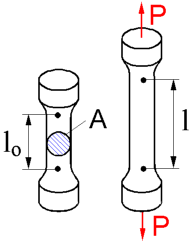 The mechanical properties of materials are primarily determined subjecting a material sample to a tension test. During a tension test the sample is gradually loaded and the force and corresponding induced elongation are recorded. In order to compare the results obtained with samples of different dimensions the quanitities of stress and strain are utilized.
The mechanical properties of materials are primarily determined subjecting a material sample to a tension test. During a tension test the sample is gradually loaded and the force and corresponding induced elongation are recorded. In order to compare the results obtained with samples of different dimensions the quanitities of stress and strain are utilized.
Stress, s = P/A [N/m=Pa] where P - force applied to the sample; A - cross sectional area of the sample.
Strain, e = Dl/lo x 100% [%]
where Dl = l - lo; l - current length; lo - initial length of the sample;
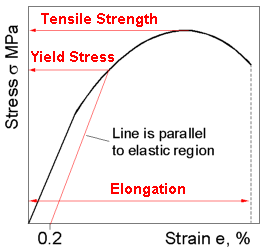 The basic mechanical properties of a material can be acquired from the stress-strain diargam which results from a tensile test.
The basic mechanical properties of a material can be acquired from the stress-strain diargam which results from a tensile test.
To determine the yield stress from a stress-strain curve:
1. Find the point of 0.002 = 0.2% on the strain axis.
2. Draw a line parallel to the elastic region of the curve.
3. The intersection of the line and stress-strain curve corresponds to the yield stress of the material.
The ultimate tensile strength is defined as the maximum value of stress reached in tensile test before fracture of the sample.
Ductility can be determined in a material with the use of the following:
Elongation = (lf - lo)/lo x 100%
Reduction in area = (Af - Ao)/Ao x 100%
where indexes o and f correspond to initial and final values at fracture respectivily.
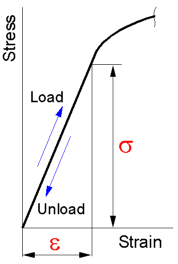 The measure of material stiffness is defined as the elastic modulus. This quantity is determined from the initial range of the stress-strain diagram during which the material exhibits linear elastic behavior. In this region the sample will return to its original shape and dimensions upon unloading.
The measure of material stiffness is defined as the elastic modulus. This quantity is determined from the initial range of the stress-strain diagram during which the material exhibits linear elastic behavior. In this region the sample will return to its original shape and dimensions upon unloading.
Elastic modulus, E = s/e [Pa]
The resistance to deformation in a material increases as the magnitude of the elastic modulus becomes greater.
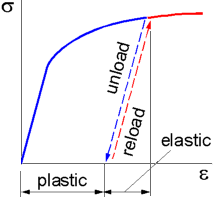 Consider a test when a material is loaded beyond its yield stress. Upon unloading the stress follows a line parallel to the elastic range of the stress-strain curve. Futhermore, only the elastic deformation is recovered. The yield stress of a plastically deformed material is higher than its initial value. Upon reapplying the load the material deforms elastically until the new yield stress is reached. It should be noted that the elastic modulus of the material remains constant.
Consider a test when a material is loaded beyond its yield stress. Upon unloading the stress follows a line parallel to the elastic range of the stress-strain curve. Futhermore, only the elastic deformation is recovered. The yield stress of a plastically deformed material is higher than its initial value. Upon reapplying the load the material deforms elastically until the new yield stress is reached. It should be noted that the elastic modulus of the material remains constant.
|
|
|
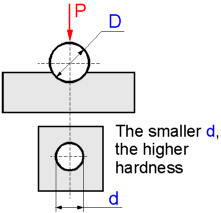 Hardness is the ability of a material to resist the indentation of a harder solid. The most common hardness tests are accomplished by forcing a small indenter into the surface of the sample material.
Hardness is the ability of a material to resist the indentation of a harder solid. The most common hardness tests are accomplished by forcing a small indenter into the surface of the sample material.
The picture shows the setup of the Brinell's hardness test. In general, hardness is proportional to the tensile strength of the material as both characteristics show a resistance of the material to plastic deformation.
 2015-08-13
2015-08-13 461
461








